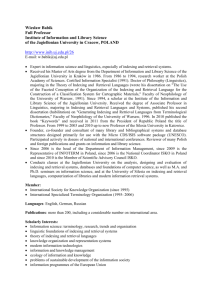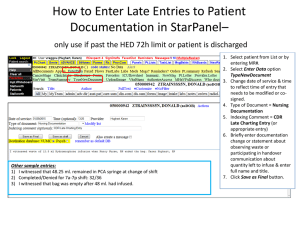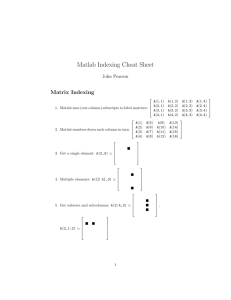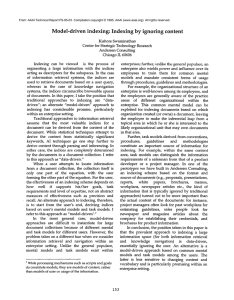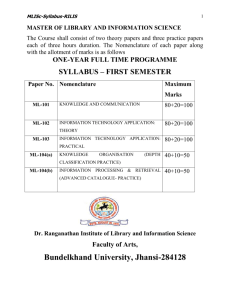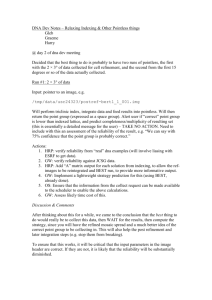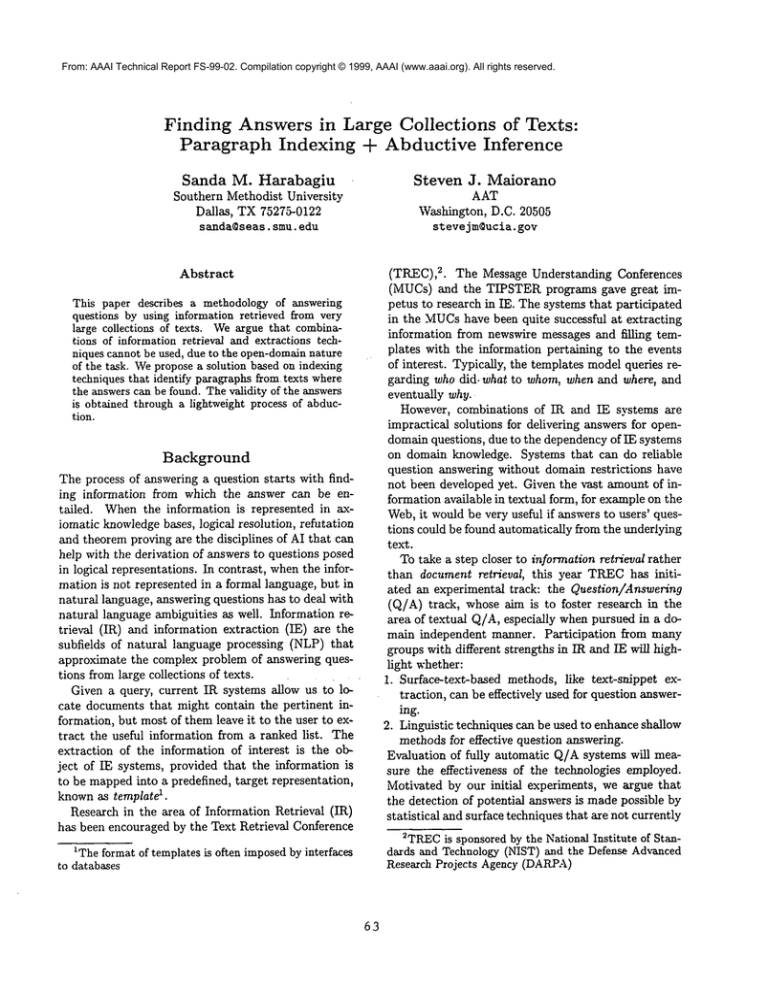
From: AAAI Technical Report FS-99-02. Compilation copyright © 1999, AAAI (www.aaai.org). All rights reserved.
Finding Answers in Large Collections of Texts:
Paragraph Indexing W Abductive Inference
Steven J. Maiorano
Sanda
M. Harabagiu
Southern Methodist University
Dallas, TX 75275-0122
sanda~seas, smu. edu
AAT
Washington, D.C. 20505
stevejm©ucia.gov
(TREC),2. The Message Understanding Conferences
(MUCs) and the TIPSTER programs gave great impetus to research in IE. The systems that participated
in the MUCshave been quite successful at extracting
information from newswire messages and filling templates with the information pertaining to the events
of interest. Typically, the templates modelqueries regarding who did. what to whom, when and where, and
eventually why.
However, combinations of IR and IE systems are
impractical solutions for delivering answers for opendomain questions, due to the dependency of IE systems
on domain knowledge. Systems that can do reliable
question answering without domain restrictions
have
not been developed yet. Given the ,~ast amount of information available in textual form, for exampleon the
Web,it would be very useful if answers to users’ questions could be found automatically from the underlying
text.
To take a step closer to information retrieval rather
than document retrieval,
this year TREChas initiated an experimental track: the Question~Answering
(Q/A) track, whose aim is to foster research in the
area of textual Q/A, especially when pursued in a domain independent manner. Participation
from many
groups with different strengths in IR and IE will highlight whether:
1. Surface-text-based methods, like text-snippet extraction, can be effectively used for question answering.
2. Linguistic techniques can be used to enhance shallow
methods for effective question answering.
Evaluation of fully automatic Q/A systems will measure the effectiveness of the technologies employed.
Motivated by our initial experiments, we argue that
the detection of potential answers is made possible by
statistical and surface techniques that are not currently
Abstract
This paper describes a methodology of answering
questions by using information retrieved from very
large collections of texts. Weargue that combinations of information retrieval and extractions techniques cannot be used, due to the open-domainnature
of the task. Wepropose a solution based on indexing
techniques that identify paragraphs from texts where
the answers can be found. The validity of the answers
is obtained through a lightweight process of abduction.
Background
The process of answering a question starts with finding information from which the answer can be entailed. Whenthe information is represented in axiomatic knowledgebases, logical resolution, refutation
and theorem proving are the disciplines of AI that can
help with the derivation of answers to questions posed
in logical representations. In contrast, whenthe information is not represented in a formal language, but in
natural language, answering questions has to deal with
natural language ambiguities as well. Information retrieval (IR) and information extraction (IE) are
subfields of natural language processing (NLP) that
approximate the complex problem of answering questions from large collections of texts.
Given a query, current IR systems allow us to locate documents that might contain the pertinent information, but most of them leave it to the user to extract the useful information from a ranked list. The
extraction of the information of interest is the object of IE systems, provided that the information is
to be mappedinto a predefined, target representation,
knownas 1.
template
Research in the area of Information Retrieval (IR)
has been encouraged by the Text Retrieval Conference
~TREC
is sponsored by the National Institute of Standards and Technology (NIST) and the Defense Ad,-anced
Research Projects Agency (DARPA)
1Theformat of templates is often imposedby interfaces
to databases
63
employed either in IR or in IE systems. The assessment
of the validity of an answer is provided by a weighted
abductive inference, operating on an ad-hoc knowledge
representation.
This method contrasts with traditional
ontology-based systems which employ symbolic reasoners, normally giving "all or nothing" types of answers.
answers from the first category, whereas Table 3 illus3.
trates two possible answers from the second category
Question 1
Answer1
Sourog
Question 2
Classification
of questions
Answer2
The TREC Q/A Track specifies
two restrictions
for
the questions.
First, questions should have an exact
answer that occurs in some document from the underlying text collections.
Table 1 lists the number of
documents and their sources, whereas Figure 1 illustrates
the format of documents through one example
from the LA Times collection.
Sourr~
Question3
Answer 3
Sourc~
Question 4
Answer 4
Source
, Nr. DocumentsPercentage
LA Times
22,715
0.34%
Forei9 n Broadcast
6,265,666
95.53%
Information Service
Federal Register
60,089
0.91%
Financial Times
210,158
3.22%
TOTAL
100%
6,558,628
Sourc.8
Question 5
Answer 5
SoBrcg
Who shot President Abraham Lincoln?
John Wilkes Booth
LA042389-0067
How many lifes were lost in the Pan Am
crash in in Lockerbie, Scotland?
27O
LA012589-0105, LA042689-0020
Howlong does it take to travel from
London to Paris through the Chunnel?
three hours 45 minutes
FT944-8324
Which Atlantic hurricane had the
highest recorded wind speed?
Gilbert (with wind speeds exceeding
200 m.p.h.)
LA120389-0130,
LA092089-0027
Which country has the largest part of the
Amazonrain forest?
Brazil (which has 60Vo)
LA032590-0089
Table 2: Short answers (first
Table 1: Collections
of documents
II Question
~Vho was Lincoln’s Secretary of State?
Booth schemed to kill Lincoln while
his compatriots would murder Vice
President Andrew Johnson and
Secretary of State William Seward.
Answer-2
to kill Lincoln while his compatriots
(250bytes) would murder Vice President Andrew
Johnson and Secretary of State William
Seward. Only Booth was successful,
II
Answer-1
(sentence)
<DOC>
<DOCNO>LA042389-0067</DOCNO>
<DOCID>47702 </DOCID>
<DAT>
<p>
April 23, 1989, Sunday,Home
Edition
</p>
<p>
Twostrangers, onewith a brokenleg arrived at the Maryland
farmhouseof Dr, SamuelMuddearly on April 15, 1865. Dr. Mudd
set the injuredman’sleg andafterwardinvited his patient and
guestto rest in a sparebedroom.
Table 3: Answers from the second category.
The simplicity
of the task formulated for the Q/A
TRECtrack is quite intentional,
because it promotes
large scale independent domain Q/A over systems that
handle more sophisticated,
domain dependent questions. Due to the length restrictions,
questions that
will be processed in the first experiments of the TREC
Q/A track fall in Class 1 out of the five classes of
questions 4, listed in Table 4.
Since the answers to questions from Class 2 need
to comprise multiple sentences, they do not meet the
length constraints
set by the TRECQ/A guidelines.
Moreover, answers are expected to indicate the document where they occur, thus answers from the Class
3 do not qualify, as they are derived from information
distributed across several texts.
</p>
<p>
Thepatient wasJohnWiResBooth,whohours earlier had fatally
shot President Abraham
Lincolnat Ford’s Theater in Washington
D.C., about30 miles away.
</p>
</DO(::>
Figure
category).
i:
SGMLformat
of document
The second restriction
applies to the length of the
answer. There are two answer categories.
The first
one limits the length to 50 contiguous bytes of text
whereas the second category comprises answers that
either (a) represent a sentence or (b) are under
bytes of text. Table 2 lists a set of questions and their
3These questions and answers were provided by the
NIST organizers of the Q/A track of the TRECConference.
4Classification proposed on the Q/A discussion mailing
list.
64
initiative 5 One of these evaluations was the Crisis
Management Challenge Problem (CMCP), designed
address questions about international crises, such as "
Whatwill the USresponse be if Iran closes the Strait
of Hormuz?"(Cohen et a1.1998).
6 competition focused on the
The scope of the CMCP
reasoning aspect of Q/A. This was made possible by
the availability of: (1) commonsenseontologiesT; and
(2) by parameterizing the questions with question
grammar.Figure 2 illustrates
some of the parameterized questions (PQ) and corresponding sample questions (SQ) used in CMCP.
Length and document uniqueness requirements do
not apply to answers for questions from Class 4, since
a coherent discourse spans several sentences, possible
from several documents. Finally, questions from Class
5 impose answers produced by reasoning and implications, thus they would rarely have the answer occurring
in some document.
Class 1
The answer is:
single datumor list of items
found in verbatim
~Ucs:
who, when, where, how (old, much, large)
PQ5-6, 87,89 [ What{amount,fraction} of <InternationalAgentl>’s
<EcenomieMeasure1> comes from <EzonomicMeasure2>(in
<UaitOfMeasure>)]?
Whois the president of France?
Whowere the AmericanPresidents of
the last Century?
Class 2
[ SO5:Howmuchoil doe~.~=pa.~ ptu~hasefromthe Persian Gulf states?
~7, 5t217: Howmuchdid Iran spend on military hardware inports
in 1994(in 1990 US$)
~ usually
in a paragraph
or two
[ Characteristics:
.....
[ Extract facts not stated in a single datum
es:
PQ22[What effect might an <IntemationalActionType>have on
the {price, supply, demand}of/for <ProductType>
on { the
international, <Country>’sdomestic} market?
<Intern ation aActionType>=
{terrorist attack on <IntemafionalAgent>’s<ProductType>
:’a~,;iL;es, itmycott, emoargo}of <ProductType>
by
<IntemationalAgentl> against <ImernationalAgent2>,
blockade of <Country>, <HPKB:BodyOfWater>}
by
<IntemationalAgent>
......
~
The answer is:
[:
[Characteristic&:
Claes.~ ~.~ ~- :.~e/ contrastive response
Examples:
Whatare the various opinions about legal
drug use?
The answeris:
an analysis of the retrieved information
Characteristics:
Class 4 The answeris synthesized coherently from
several retrieved fragments
Examples:
Create an argumentto convince people to
stop immigration
Shouldthe Fed raise interest rates at their
next meeting in May?
Theanswer is:
the result of complexreasoning
Characteristics:
Class 5
Need of extensive world knowledge
and commonsense
rea~soning capabilities
in conjunction with domainknowledge
Examples:
Whatshould be the defense strategy in
the O.J. Simpson murder case?
SQ22: Whateffect on the price of oil on the intemalJonalmarketare
likely to result fromthe terrorist attacks on Saudioil facilities
on Days 22, 23 and 25?
Figure 2: Parameterized questions
questions (SQ) for the C~_CPtczts
(PQ) and sample
The knowledge sources employed in the CMCPcompetition are listed in Figure 3. Each of the knowledge
sources are represented by Webpages, in which fragments of texts are manually tagged as relevant for the
CMCPcompetition. Figure 3 illustrates
one such annotation. The tagged fragments do not specify the
parameterized questions to which they are relevant.
The open-domain characteristic
of questions from
the TRECQ/A track makes it impossible to generate a grammar of questions. Instead, we conjecture
that all questions from Class 1 are either (1) requests
for fillers of some thematic role of a structure defined
by the question or (2) requests for subordinates of
Table 4: Classes of questions
~HPKB is
sponsored
by
DARPA (cf.
http : //www.teknowledge.eom).
6CMCP
was designed by a team fi:om IET, Inc and PSI~
Corp., led by Robert Schrag.
rOntolo~es were based oa Cyk, the commonsense
knowledgebase developed by Cy~rp for the past decade
Questions from the Class 5 axe addressed by research
techniques that rely on ontological resources, coupled
with derk~ational devices. An example of such endeavors is provided by the evaluations taking place under the High Performance Knowledge Bases (HPKB)
65
concept specified by the question. The ultimate goal
of the TRECQ/A evaluations is to assess whether the
current technology can produce automatically annotations that represent answers from the TRECcorpora.
Unlike the annotations employed in the CPCMtask,
the TRECQ/A answers are very short fragments of
text, unbound to any prespecified domain.
ask for the identification of objects with given properties. Examplesare Questions 4 and 5 from Table 2.
3. Class 1.c consisting of questions of taxonomic nature. The answer should enumerate subordinate objects or entities. An example is "Whatare the forms
of international crimes committed in Latin America?". Questions related to the cardinality of a set
are also classified in this category. Question 2 from
Table 2 is an example.
To be abIe to identify relevant answers to questions
from any of the above categories, we have two choices:
(a) to use IR techniques and extract the answers from
the returned documents or (b) to parse all texts and
derive conceptual indexes. The first method relies on
indexing techniques developed for document retrieval.
Semantic ambiguity is the obstacle that makes the second choice impractical at the moment, although we
are aware of efforts for building open-domain semantic indexes (Woods1997). Therefore, we have decided
to index all texts such that we can return paragraphs
where the answers might lie instead of documents that
contain relevant information for the questions. This
reduces significantly the inspection time.
Intemational~.~._~Security Links
--Devil’sBrewBriefings- Iran/Iraq/Syria
-- NatioanlBriefings- Iran/Iraq/Syria
-- TheMissile MasterTable: Afghanistan-Eritrea/
¯
International Security ~\ Saudi Arabia-Yemen
-- Finland Japan
¯
Jane’s UnderwaterWarfareSystems1996-1997
......................
1996GlobalTerrorism:MiddleEast Overview/
~ State-Sponsored Terrorism
I
EnergyLinks
~ ...................
Indexing
L OPEC FACTSheet
L ’ Iraq/Iran/SaudiArabia/Kuwait/Qatar/Egypt
........
for
Q/A
There is no question that the performance of a Q/A
system that operates on textual documents depends
in a large measure on its indemg capabilities. To us,
and manyother users of IR systems and search engines
over the Internet, it has becomeapparent that indexing
for Q/Ashould be handled differently than in classical
IR systems, because we should not retrieve relevant
documents, but indexes to paragraphs from documents
where the answer may be found.
There are a number of options for searching and indexing large and distributed collections of documents,
each with its strengths and weaknesses. Searching solutions fall into two broad categories: single versus distributed search engines. A single engine builds a full
index of the entire collection of documents, whereas
distributed search indexes s combine results from severa] search engines.
The most popular search techniques are the vectorspace search, widely used in IR (Buckley et al.1998)
(Sa]ton 1975) and boolean search, employed by several
Internet search engines (e.g. Altavista). Indexing can
be either based on word frequencies (weight indexing)
or probabilistic. Another option for indexing is provided by hyperlinks that can be generated automaticaUy when computing semantic similarity (cf. (Green
1997)). H~perlink indexing pro~ddes with a representa-
~
.EconomicLinks
Economic
Policy and TradePractices Report(1996)
Oman]Algeria/Egypt/Sy
ria/IsreaYTunisia/Jordarg
.....
Multilateral OrganizationLinks
ARABSA,OPEC, OECD, NATO, IAEA, UN .........
TheSecurity Councilhas primaryresponsability,
underthe Charterfor the maintenance
of internationalpeace
andsecurity
.......................................
Figure 3: Knowledge Sources for CMCP
Wedistinguish three categories of questions from
Class 1:
1. Class 1.a comprising questions about the subjects,
objects, manner, time or location of a certain action or event. Questions 1 and 3 from Table 2 are
elements of this class.
2. Class 1.b made of queries about the properties or
attributes of a certain person, place, object or phenomenon. This class contains also questions that
SAlso knownas meta-search engines
66
tion of knowledge sources similar to the one employed
in CMCP.
Vector-space
indexing
Under the vector-space model, documents and queries
are conceptually represented as vectors (cf. (Salton
1989)). If the vocabulary contains n words, a document D is represented as a normalized n-dimensional
vector D=<wl,w2,...,wn>, where wi is the weight assigned to the word (term) ti. If ti is not present in D,
then wi is 0. The weight wi indicates howstatistically
significant wordti is.
One common way of obtaining
document vector
D is by first computing the un-normalized vector
I
l
I
D I__
-<wl,w2,...,w,>,
where each wi I is the product of
the wordfrequency factor ( t]) with an inverse firequency
factor (id]). This indexing scheme assigns the largest
weight to those terms which occur with high frequency
in individual documents, but are at the same time relatively rare in the collection as a whole. The tf factor is
equal (or proportional) to the frequency of the i th word
within document d. The idf factor represents the content discriminating power of the i th word, and is typically computed by log~, where N is the total number
of documents in the collection and di is the number of
documents containing the i th word. Once D’ is computed, the normalized vector D is typically obtained
t
~/Ei.=l(Wi
by dividing each element w
,) 2.
i with " n
Questions (queries) in the vector-space model are
also represented as normalized vectors over the word
space, Q=<ql,q2,...,qm>, where qi=rl.idf, in which ri
is the number of times term ti appears in the query.
The retrieval of a relevant document is based on
the similarity (Sire) computation obtained as an inner
product of the query and document vectors:
. .
tr
-~-
ClNp+(Cl
1 mzn
. (d(z, 3 ), c2) ) + Nt
~=Vll ~j =i+N~,
*
e2~"lVv--1
~k=l {~v
- k)
c3
where Np is the numberof query terms that are present
in the document(each term is counted only once), Nt is
the total number of query terms in the document (each
term is counted as manytimes as it appears), d(i,j)
is the minimumdistance between the /-th and the jth query terms which are present in the document.
Constant cl controls the magnitude of tr, whereas c2
specifies the maximumdistance between query terms
9.
and c3 specifies the importance of term frequency
The inverse relevance factor can be computed as
.
Irlp
,dr=log(N/l-Ik=t
dk), where np is the number of terms
in the same paragraph and dk is the number of documents containing the kth term.
Boolean indexing
The Boolean model is more primitive than the vectorspace model, but" it is important because manysources
still use it for answeringqueries. Moreover,our initial
experiments under the TRECQ/A track proved that
the boolean index, built by Altavista was superior to
the vector-model index, provided by the PRIZEsearch
engine publicly available from NIST. Wehave postprocessed the retrieved documents with a simple operator, called Paragraph (Moldovan and Mihalcea 1998),
which identifies document paragraphs that contain the
majority of the query terms or their WordNet(Miller
1995) synonyms. Wewere able to find the answer to
a question in at least one of the paragraphs in at least
43%of the cases. Weconclude thus that boolean indexing is a technique that should be considered for
textual Q/A.
In Boolean indexing, documents are represented as
words with position information. Queries are expressions composed of words and connectives such as
"and", "or", "not" and proximity operators such as
"within k words of". The answer to the query is the
set of all the documents that satisfy the Boolean expression. Because the Boolean model does not rely
on document-query similarities (i.e. a document does
or does not satisfy a query), the indexing structure
is made of a collection of document vectors. Wecan
refine boolean indexing, by building clusters of documents that present high similarities,
as proposed in
(Li and Danzig 1997). Well knownsimilarities, such
Dice’s coefficient, Jaccard’s coefficient, Cosine similarity and Overlap similarity (van Rijsergen 1979) can be
used to provide for a cluster-based retrieval. Radecki
n
Sim(Di, Qj) = Z(wik * qjk)
k=l
Another similarity measure used in the vector space
model is the cosine similarity:
Cos(Di, Qi) ~-~=1 (wik ¯ qj k)
-~)-~k=l
- qjk
2
~/~-k=l w~k
To be able to retrieve paragraphs relevant to a
question instead of documents, we have modified the
weighting scheme of the vector-space. Instead of the
indexing based on tf*idf weights, we use a weighting
method that promotes the proximity of query terms
in the document. Weights are computed by the product tr*idr, where tr measures the term relevance. The
term relevance is calculated using a formula employed
by the Inquirus meta-search engine (Lawrence and
Giles), whereas idr represents the content discriminating power of all the words from the same paragraph.
The formulae are:
9In Inquirus cl--100, c2--5000 and ca=lOct
67
has employedseveral measures to rank similarities between boolean queries and clusters of documents. New
similarities based on his formula were proposed in (Li
and Danzig 1997). Given a boolean query Q and
cluster of documents R, their similarity is measured
by:
S(Q,R) = I Ca(Q)l~rr(R)
I CR(Q)
U(R)
where ~bR(Q) represent all the boolean matches of
in the cluster R and 7r(R) is the set of documentsfrom
cluster R. This similarity measure is used to estimate
the validity of the clustered index, and thus indicates a
relevance measure for a meta-search based on boolean
indexing. Such retrieval methods have been employed
by the Gloss system (Gavrano et al.1999) and the Indie
system (Danzig et al.1992).
Thesaurus, later WorchNet). Lexical chains are used to
measure similarity between documents at paragraph
level. The similarity is measured by overlap or cosine
coefficients between weighted paragraph vectors. The
weight of a paragraph is given by its density. The
density of a chain c in a paragraph p is defined as
dc, p = ~
where we p i represents the number of words
lljla ’
from chain c in paragraph p whereas wp is the number
of content words from p.
Indexing is important because it retrieves paragraphs or fragments of texts where the answer may be
found, but the recognition of the answer has to rely on
logical derivations. Weargue that indexing provides
with weight measures that can be used in the weighted
abduction method reported in (Hobbs et a1.1993).
Abduction of answers
Indexing
based on NLP
The idea of using NLPtechniques to improve IR performance is not new (Strzalkowski 1995). NLPparsing
is especially useful, since it detects syntactic phrasal
terms that can improve indexing quality. Parses are especially useful for building Q/Asystems, since subjectverb-object (SVO)patterns can be extracted as well
prepositional attachments. Syntactic information coupled with indexes to words in documents helps grfiding
the path to a question’s answer. However, syntactic
and semantic ambiguities are problems that make automatic NLPtechniques hard to be used for Q/A.
START(Katz 1997), the Q/A system built at lVIIT,
employs knowledge of verb alternations to index sentences from documents. Semantic and taxonomic information is used as well. However, the high performance of STARTis based on heavy manual annotations, thus a commoditythat we cannot obtain before
the evaluation of the TRECQ/A systems.
Another indexing method based on NLP was designed at Sun Microsystems (Woods 1997). Conceptual indexing is the result of automatically creating
a conceptual knowledge index, through classification
algorithms that combine semantic, morphological and
syntactic information. This indexer is particularly interesting, since it provides with interpretation of complex nominals, and thus builds a taxonomyof concepts
recognized from large collections of texts.
The anatomy of several new lnternet search engines
(e.g. Google (Brin and Page 1998)) shows that
indexes are created by using phrasal parsers and identifying terms as heads of phrases or complex nominals.
A third indexing method was introduced in (Green
1998), and is an automatic way of generating hyperlinks that is based on lexical chaining. Lexical chaining
is a method of detecting semantically related words in
a text, when using a thesaurus (originally the Roget’s
Givena fragmentof text, we infer that it is an answerof
a question if an expl .anation, based on semantic knowledge can be found. The process of interpreting texts
by providing explanations of whythey are the answers
to a question is knownas abductive inference. Wedistinguish two forms of abduction. The first one applies
to the interpretation of taxonomic information, used in
explaining answers to questions similar to those listed
in Table 5. The second form is based on weighted abduction, as presented in (Hobbs et a1.1993).
QI.1
Q1.2
Q1.3
Q1.4
Whowas Lincoln’s Secretary of State?
"~Vhowere the USpresidents f~omlast century?
%Vhatforms of international crime exist?
V,’-hat are somenegative phenomena
in society?
Table 5: Questions asking for taxonomic information.
The abduction of questions similar to those from Table 5 is often based on the interpretation of appositions
and on the recognition of lexico-syntactic patterns for
hyponymyor troponymy. For example, the apposition
Secretaryof State 14illiamSewardfrom the answerslistedin Table3 indicates
thatWilliam
Seward
is a Secretary
of State,
butdoesnotindicate
thathe
wasLincoln’s
Secretary
of State,
to provide
withananswerto thequestion
QI.I.To be ableto abductively
inferthis,we needtorelyon thefollowing
pragmatic,
general
axioms:
(el, Person1}
& action2(e2,Person2)
action1
| & related_events(el,e2)~
related(Pe£son_l,
Person_2)
i same_time(el,e2)
=> related_events(el,e2)
lisa(el,e2)
=> related_events
(el,e2)
Using the davidsonian treatment of events, these axioms state that two events el and e.~, if lexicalized by
two different verbs or nominals (act/anz and actions2)
68
entail a relation between the persons affected by the
events when there is a relation between the events as
well. Possible relations between events are either the
fact that they occur at the same time, or the fact that
one is the troponymof the other.
The abduction explains the relations between President Lincoln and Secretary of State William Seward. Backward chaining accounts for the explanation of the relations between the events of killing
and murdering, because we can find an isa relation in
WordNet 1.6 between the sense 1 of verb murder and
the first sense of verb kill. The cue phrase while also
indicates that the two events co-occur.
Similarly the abduction of the answer to question
Q1.2 is based on axioms representing knowledge about
the definition of the last century. Such axioms can
be derived from the defining glosses of WorchNet1.6
(Miller 1995), since we use the same lexical knowledge
base for retrieval of semantic information.
In contrast, the abduction of the answer to question Q1.3 is based on the recognition of lexico-syntactic
patterns for hypernymy (subsumption) and meronymy
(e.g. is-part, is-member relations). Several such patterns were presented in (Hearst 1998), together with
an algorithm for the acquisition of such patterns from
large corpora. Table 6 lists some of the patterns and
examples of their recognition.
Pattern 1
Example
I
Pattern 2
Example
Pattern 3
Example
Pattern
4
forms of crime, including terrorism, blackmail
and drug-related problems.]
Similarly, the answer to question Q1.4 is infered because Pattern 2 from Table 6 could be recognized in
the following paragraph:
It is important to motivate the people to participate
in the campaingagainst [corruption, smuggling, the
production of fake goods and other negative phenomenon of society.]
Lexico-syntactic patterns and appositions cannot account for the majority of answer abductions. However,
they provide with a simple methodof finding instances
and subsumersof entities, states, events or attributes,
and thus help proving relations between terms of the
question. As we have seen in the abduction of the
answer to Q1.1, some of the relations are more important than others. The fact that murdering is a
kind of killing is more important in proving the relations between "President Lincoln than Secretary of
State William Seward than the fact that the two events
take place at the same time. Therefore, we believe
that the two relation predicates should have different
weights in the explanation.
This assumption agrees with the principles
of
weighted abduction, presented in (Hobbs et a1.1993).
In that framework, axioms are represented in the format:
P~’AP~2...~QAR
nouno such as ~x~Unl{, no~n2 ...,
(andlor) nouni}
authors such as Herrick, Goldsmith and
Shakespeare
noun1 {, noun2 ...} (orland) other nouno
bruises, brokenbonesor other injuries
nouno including
nO~nn
{nounl
...}
where P~ are antecedents participating with different weights in explaining the conclusion Q. R is the
background information, that helps the backchaining.
The weights implement the intuitions
of what predicates contribute more to the derivation of a certain
conclusion.
The assignment of the weights has an ad-hoc nature in (Hobbset a1.1993), thus using the values of the
weights from the index might be an interesting solution. Weexperiment now to see whether this solution
gives better performance than the weighted abduction
schemes proposed in (Charniak and Shimony 1990).
An alternative is to compute the weights with semantic density measures over lexico-semantic networks
derived from WordNet 1.6 (Miller 1995). These networks are collections of paths that account for the abduction of answers to question. The paths are derived
in a two step process. First paths between the terms
of the questions are derived. Then, paths to terms cooccuring with question concepts in the same paragrapg
are sought. The procedure that derives these paths is:
(or[and)
common-lawcountries, including Canada
and England
nouno especially
{noun1...} (or[a.lad)
nO~nn
Example
Europeancountries, especially France,
England and Spain
Table 6: Lexico-syntactic patterns.
The answer to question Q1.3 is infered because Pattern 3 from Table 6 could be recognized in the following
paragraph:
From the point of view of guaranteeing the Slovak
Republic’s internal security, risks associated with
the following are at the forefront:
- the rise of nationalism and irredentism among
a certain part of the population with possible
tendencies toward violating the integrity of the
state’s territory.
- the rise of organized crime and [international
69
1. For all Ci, concepts from the question
2. Search the glosses of all senses of every Ci
3. If there is a collocation (wl,wz) such that
wl is a synonym, hypernym, holonym of a
wz is a synonym, hypernym, holonym of a
4.
Then found path(C1, C2)
5. For all glosses implemented in WordNet
6. If there is a collocation (wx,w2)
the gloss of (Sk), such that
Wx is a synonym, hypernym, holonym of a
w2 is a synonym, hypernym, holonym of a
Sk is related to some C3
7.
Then found path(C1, C2)
8.
found path(C1, C3)
existing 1R systems. Second, the need of validating
answers will boost knowledge based reasoning methods for NLP.After the IE field has used as its best the
shallow methods of processing texts, we take a new
step by incrementally adding techniques that rely on
knowledge resources. This endeavor will bring closer
the NLPand knowledge processing communities. Research in abduction, an inference technique believed to
be well suited for NLPprocessing, is expected to take
a central place in textual Q/A.
Cx
C2
Cx
Ce
References
The paths obtained for the question "Howmany animais and plants are threatened by extinction?" are
represented in Figure 4. To be able to infer that the
answer to this question lies in the following fragment
of a paragraph, we need to explain why sliding toward
extinction is equivalent to being threatened by extinction:
Fifteen years after Congress enacted a law to protect
endangered species, most of the nearly 500 types of
animals and plants show no sign if recovery and many
continue their slide toward extinction.
Pathl:
~ Gloss:
"extinction
of
is-raember~
Path2:
species"
j~
~ is-member
~
!~
Sergey Brin and Lawrence Page. The anatomy of a
Large-Scale Hypertextual WebSearch Engine. In the
Proceedings of the Seventh International World Wide
Web Conference, 1998.
Chris Buckley, Mandar Mitra, Janet Walz and Claire
Cardie. SMARTHight Precision:
TREC 7. In the
Proceedings of the Text Retrieval Conference TREC7, 1998.
Eugene Charnihk and S.E. Shimony. Probabilistic semantics for cost-based abduction. Technical Report
CS-90-02, Department of Computer Science, Brown
University, Providence RI, 1990.
Paul Cohen, Robert Schrag, Eric Jones, AdamPease,
Albert Lin, Barbara Starr, David Gunning and Murray Burke. The DARPAHigh Performance Knowledge Bases Project. In AI Magazine, Vol 18, No 4,
pages 25-49, 1998.
Paul Cohen, Vinay Chaudhri,
Adam Pease and
Robert Schrag. Does Prior KnowledgeFacilitate the
Development of Knowledge-Based Systems? To be
pubblished in the Proceedings of AAAI-99, 1999.
endangered~a)
Peter Danzig, Shih-Hao Li and Katia Obracczka. Distributed Indexing of AutonomousInternet Services.
ComputingSystems, Vol 5, No 4, pages 433-459, 1992.
Luis Grax~no, Hector Garcia-Molona amd Anthony
Tomasic. Gloss: Text-Source Discovery over the In- ternet. To be pubblished in the AI Journal, 1999.
Figure 4: Semantic paths obtained from WordNet
The abductive inference follows the shortest path
from the answer concepts to the question paths. For
this example, because sliding is a kind of slowly changing, and threatening is a process of becoming endangered, we can use the knowledge that becoming is a
form of changing as well, and assign a larger weight to
the threaten predicate.
Stephen J. Green. Automatically generating hypertext by computing semantic similarity.
PhDthesis,
University of Toronto, 1997.
Stephen J. Green. Automatic link generation: Can
we do better than term repetition? In the Proceedings of the Seventh International
World Wide Web
Conference, 1998.
Conclusions
Sanda Harabagiu and Dan Moldovan. A Parallel System for Text Inference Using Marker Propagations.
IEEE Transactions in Parallel and Distributed Systems, Vol 9, no 8, pages 729-748, 1998.
Webelieve that the nature and complexity of the task
of textual Q/A will impact research in NLPin a major
way. First, new indexing technologies will bootstrap
7O
Sanda Harabagiu and Dan Moldovan. Knowledge
Processing on Extended WordNet. In WordNet: An
Electronic Lexical Database and Some of its Applications, editor Fellbaum, C., MIT Press, Cambridge,
MA, 1998.
Gerard A. Salton. A theory of indexing. Regional
Conference Series on Applied MAthematics, No 18,
SIAM, Philadelphia, PA, 1975.
Gerard A. Salton. Automatic Text Processing: The
transformation, analysis and retrieval of information
by computer. Addison-Wesley, 1989.
Marti Hearst. Automated Discovery of WordNet Relations. In WordNet: An Electronic Lexical Database
and Some of its Applications, editor Fellbaum, C.,
MIT Press, Cambridge, MA, 1998.
TomekStrzalkowski. Robust Text Processing in Automated Information Retrieval. In Readings in Information Retrieval, pages 317-322, 1995.
Lynette Hirschman, Marc Light, Eric Breck and John
D. Burger. Deep Read: A Reading Comprehension
System. In the Proceedings of the 37th Meeting of the
Association for Computational Linguistics (.4 CL-99),
pages 325-332, University of Maryland, 1999.
B. Sundheim. Proceedings. Sixth Message Understanding Conference (MUC-6) August, 1995.
Jerry Hobbs, Mark Stickel, Doug Appelt, and Paul
Martin. Interpretation as abduction. Artificial Intelligence, 63, pages 69-14"2, 1993.
William A. Woods. Conceptual Indexing: A Better
way to Organize Knowledge. Technical Report of Sun
Microsystems Inc., 1997.
C.J. van Rijsergen. Information Retrieval.
Butterworth & Co, 1979. August, 1995.
Boris Katz. From Sentence Processing to Information
Access on the World Wide Web. Proceedings of the
AAAI Spring Symposium, pages 77-86, 1997.
Julian Kupiec. MURAX:A Robust Linguistic
Approach for Question Answering Using an On-line Encyclopedia. In the Proceedings of the 16th International ACMSIGIR Conference on Research and
Development in Information Retrieval (SIGIR-93),
pages 181-190, Pittsburg, PA, 1993.
P.S. Jacobs. Text Power and Intelligent Systems. In
Lawrence Erlbanm Associates, Text-Based Intelligent
Systems, pages 1-8. ,editor Jacobs, P.S., Hillsdale,
N.J., 1992.
Steve Lawrence and Lee Giles. Inquirus, the NECI
meta search engine. In the Proceedings of the Seventh
International World Wide Web Conference, 1998.
D.B. Lenat. CYC: A Large-Scale
Investment in
Knowledge Infrastructure.
Communication of the
ACM, vol 38: Noll, pages 32-38, November, 1995.
Shih-Hao Li and Peter Danzig. Boolean Similarity
Measures for Resource Discovery. IEEE Transactions
on Knowledge and Data Engineering, Vol 9, No 6,
pages 848-862, 1997.
G.A. Miller. WordNet: A Lexical Database. Communication of the ACM, vol 38: Noll, pages 39-41,
November 1995.
Dan Moldovan and Rada Mihalcea. A WordNet-based
Interface to Internet Search Engines. In Proceedings
of the FLAIRS-98, pages 275-279, 1998.
Gerard A. Salton and M.E. Lesk. Computer Evaluation of Indexing and Text Processing. Journal of the
ACM, Vol 15, No 1, Pages 8-36, January 1968.
71
London,

